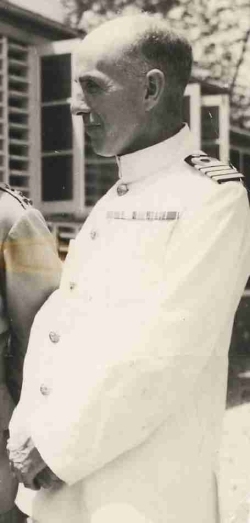- Author
- Rosenweig, Paul A.
- Subjects
- History - WW2, Biographies and personal histories
- Tags
-
- RAN Ships
- HMAS Tolga, HMAS Coonawarra, HMAS Australia II, HMAS Melville, HMAS Moresby I, HMAS Hobart I, HMAS Swan II, HMAS Adelaide I
- Publication
- September 2003 edition of the Naval Historical Review (all rights reserved)

ON TUESDAY 19 FEBRUARY 2002, a commemorative service was held in Darwin to mark the sixtieth anniversary of the bombing of Darwin. Before the Cenotaph, former Governor-General Sir Zelman Cowen spoke of the two Japanese air attacks on 19 February 1942 which ‘. . . brought war to the Australian mainland for the first time . . .’ – attacks which were responsible for 292 known deaths.
Other speakers, with political correctness, spoke of the actions of ‘the enemy’ on that fateful day – only Zelman Cowen, who had himself been present in Darwin in February 1942, referred more specifically to the bombing raids conducted by the Japanese and what their intent was believed to be. Sir Zelman had then been a Sub-Lieutenant serving at HMAS Melville, Naval Headquarters in Darwin, and as guest speaker on 19 February a decade earlier during the Northern Territory’s War Service Commemoration Year 1992, had recalled his impression on that day in 1942:
‘I remember early morning talk in Naval Headquarters about unidentified aircraft; suddenly the warning sounded and we streamed out to the trenches . . . I remember listening that night to the talk of more senior officers about the imminent prospect of attack, which was assumed as a certainty.’
Among those senior officers was Cowen’s Commanding Officer, Commander Laurance ‘Pup’ Tozer RAN, already a veteran of active service off northeast Africa, who came to have a significant association with Darwin.
Laurance Tozer was born in North Melbourne on 17 March 1902 and, at the age of 13 years 9 months, entered the new RAN College at Captain’s Point, Jervis Bay, as a Cadet Midshipman, a member of the fourth intake. He first saw service in vessels of the Australian Fleet, and gained experience of Loan Service with the Royal Navy on three occasions during the 1920s and 1930s. Bill Cook, one of the Divisional Midshipmen, recalled that Lieutenant-Commander Tozer was Divisional Officer of the Foretop Division in HMAS Australia (II) in 1934-36:
‘’Pup’, as he was known to his contemporaries – but never addressed by this nickname by Midshipmen! – was a short nuggetty man, almost always in good mood, often grinning or laughing, generally of very pleasant disposition and well liked by sailors and both his senior and junior officers. He (was) what was known in the service as a ‘salt horse’ – being considered more a seaman – as opposed to a gunnery, torpedo or other specialist.’
As a Commander, Tozer was Executive Officer of the 6-inch cruiser HMAS Adelaide, escorting the first convoy of Second AIF and NZ troops destined for the Middle East. He returned to Adelaide in 1943-44 as Executive Officer, followed by five months as Commanding Officer and Commander Task Force 71. Fred Cooper, an 18 year old stoker in 1943, recalled the day Tozer was first welcomed aboard Adelaide as Commanding Officer:
‘Captain Esdaile was a rather remote and aloof type, whereas Tozer was rather the opposite, he was well liked by Adelaide’s lower deck ratings. When he first came on board, he was given the customary bosun’s pipe for senior officers, and he asked for them to restrain from this custom when he was boarding, or going ashore, in future.’
Cooper recalled the difference in Tozer’s leadership compared to his more rigidly formal predecessors:
‘I remember one Saturday, myself and three mates were on shore leave, having been ‘sampling’ beers in several Fremantle pubs since midday, decided to catch a bus to Perth, this was about 4 p.m. and it would be fair to say we were in a carefree mood. Whilst waiting at the bus stop, a sedan car pulls up, and a voice said ‘Want a lift, lads?’ I jumped in the front and my three mates got in the back. The driver turned out to be our new captain in civvies. Of course we were rather taken aback as we had caps flat aback, jacket sleeves unbuttoned and turned back, and a little the worse for wear. He never said a word about our sloppy appearance and was most friendly . . . In the Navy in those days officers and ratings only spoke when it was official duties so the gap between the two was rather wide.’




